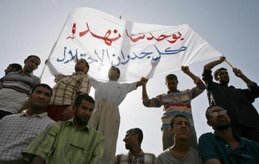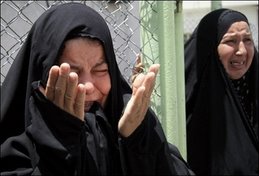It Is The Death of History
The Independent
17/09/07
by Robert Fisk
2,000-year-old Sumerian cities torn apart and plundered by robbers. The very walls of the mighty Ur of the Chaldees cracking under the strain of massive troop movements, the privatisation of looting as landlords buy up the remaining sites of ancient Mesopotamia to strip them of their artefacts and wealth. The near total destruction of Iraq’s historic past - the very cradle of human civilisation - has emerged as one of the most shameful symbols of our disastrous occupation.
Evidence amassed by archaeologists shows that even those Iraqis who trained as archaeological workers in Saddam Hussein’s regime are now using their knowledge to join the looters in digging through the ancient cities, destroying thousands of priceless jars, bottles and other artefacts in their search for gold and other treasures.
In the aftermath of the 1991 Gulf War, armies of looters moved in on the desert cities of southern Iraq and at least 13 Iraqi museums were plundered. Today, almost every archaeological site in southern Iraq is under the control of looters.
In a long and devastating appraisal to be published in December, Lebanese archaeologist Joanne Farchakh says that armies of looters have not spared “one metre of these Sumerian capitals that have been buried under the sand for thousands of years.
“They systematically destroyed the remains of this civilisation in their tireless search for sellable artefacts: ancient cities, covering an estimated surface area of 20 square kilometres, which - if properly excavated - could have provided extensive new information concerning the development of the human race.
“Humankind is losing its past for a cuneiform tablet or a sculpture or piece of jewellery that the dealer buys and pays for in cash in a country devastated by war. Humankind is losing its history for the pleasure of private collectors living safely in their luxurious houses and ordering specific objects for their collection.”
Ms Farchakh, who helped with the original investigation into stolen treasures from the Baghdad Archaeological Museum in the immediate aftermath of the invasion of Iraq, says Iraq may soon end up with no history.
“There are 10,000 archaeological sites in the country. In the Nassariyah area alone, there are about 840 Sumerian sites; they have all been systematically looted. Even when Alexander the Great destroyed a city, he would always build another. But now the robbers are destroying everything because they are going down to bedrock. What’s new is that the looters are becoming more and more organised with, apparently, lots of money.
“Quite apart from this, military operations are damaging these sites forever. There’s been a US base in Ur for five years and the walls are cracking because of the weight of military vehicles. It’s like putting an archaeological site under a continuous earthquake.”
Of all the ancient cities of present-day Iraq, Ur is regarded as the most important in the history of man-kind. Mentioned in the Old Testament - and believed by many to be the home of the Prophet Abraham - it also features in the works of Arab historians and geographers where its name is Qamirnah, The City of the Moon.
Founded in about 4,000 BC, its Sumerian people established the principles of irrigation, developed agriculture and metal-working. Fifteen hundred years later - in what has become known as “the age of the deluge” - Ur produced some of the first examples of writing, seal inscriptions and construction. In neighbouring Larsa, baked clay bricks were used as money orders - the world’s first cheques - the depth of finger indentations in the clay marking the amount of money to be transferred. The royal tombs of Ur contained jewellery, daggers, gold, azurite cylindrical seals and sometimes the remains of slaves.
US officers have repeatedly said a large American base built at Babylon was to protect the site but Iraqi archaeologist Zainab Bah-rani, a professor of art history and archaeology at Columbia University, says this “beggars belief”. In an analysis of the city, she says: “The damage done to Babylon is both extensive and irreparable, and even if US forces had wanted to protect it, placing guards round the site would have been far more sensible than bulldozing it and setting up the largest coalition military headquarters in the region.”
Air strikes in 2003 left historical monuments undamaged, but Professor Bahrani, says: “The occupation has resulted in a tremendous destruction of history well beyond the museums and libraries looted and destroyed at the fall of Baghdad. At least seven historical sites have been used in this way by US and coalition forces since April 2003, one of them being the historical heart of Samarra, where the Askari shrine built by Nasr al Din Shah was bombed in 2006.”
The use of heritage sites as military bases is a breach of the Hague Convention and Protocol of 1954 (chapter 1, article 5) which covers periods of occupation; although the US did not ratify the Convention, Italy, Poland, Australia and Holland, all of whom sent forces to Iraq, are contracting parties.
Ms Farchakh notes that as religious parties gain influence in all the Iraqi pro-vinces, archaeological sites are also falling under their control. She tells of Abdulamir Hamdani, the director of antiquities for Di Qar province in the south who desperately - but vainly - tried to prevent the destruction of the buried cities during the occupation. Dr Hamdani himself wrote that he can do little to prevent “the disaster we are all witnessing and observing”.
In 2006, he says: “We recruited 200 police officers because we were trying to stop the looting by patrolling the sites as often as possible. Our equipment was not enough for this mission because we only had eight cars, some guns and other weapons and a few radio transmitters for the entire province where 800 archaeological sites have been inventoried.
“Of course, this is not enough but we were trying to establish some order until money restrictions within the government meant that we could no longer pay for the fuel to patrol the sites. So we ended up in our offices trying to fight the looting, but that was also before the religious parties took over southern Iraq.”
Last year, Dr Hamdani’s antiquities department received notice from the local authorities, approving the creation of mud-brick factories in areas surrounding Sumerian archaeological sites. But it quickly became apparent that the factory owners intended to buy the land from the Iraqi government because it covered several Sumerian capitals and other archaeological sites. The new landlord would “dig” the archaeological site, dissolve the “old mud brick” to form the new one for the market and sell the unearthed finds to antiquity traders.
Dr Hamdani bravely refused to sign the dossier. Ms Farchakh says: “His rejection had rapid consequences. The religious parties controlling Nassariyah sent the police to see him with orders to jail him on corruption charges. He was imprisoned for three months, awaiting trial. The State Board of Antiquities and Heritage defended him during his trial, as did his powerful tribe. He was released and regained his position. The mud-brick factories are ‘frozen projects’, but reports have surfaced of a similar strategy being employed in other cities and in nearby archaeological sites such as the Aqarakouf Ziggarat near Baghdad. For how long can Iraqi archaeologists maintain order? This is a question only Iraqi politicians affiliated to the different religious parties can answer, since they approve these projects.”
Police efforts to break the power of the looters, now with a well-organised support structure helped by tribal leaders, have proved lethal. In 2005, the Iraqi customs arrested - with the help of Western troops - several antiquities dealers in the town of Al Fajr, near Nasseriyah. They seized hundreds of artefacts and decided to take them to the museum in Baghdad. It was a fatal mistake.
The convoy was stopped a few miles from Baghdad, eight of the customs agents were murdered, and their bodies burnt and left to rot in the desert. The artefacts disappeared. “It was a clear message from the antiquities dealers to the world,” Ms Farchakh says.
The legions of antiquities looters work within a smooth mass-smuggling organisation. Trucks, cars, planes and boats take Iraq’s historical plunder to Europe, the US, to the United Arab Emirates and to Japan. The archaeologists say an ever-growing number of internet websites offer Mesopotamian artefacts, objects anywhere up to 7,000 years old.
The farmers of southern Iraq are now professional looters, knowing how to outline the walls of buried buildings and able to break directly into rooms and tombs. The archaeologists’ report says: “They have been trained in how to rob the world of its past and they have been making significant profit from it. They know the value of each object and it is difficult to see why they would stop looting.”
After the 1991 Gulf War, archaeologists hired the previous looters as workers and promised them government salaries. This system worked as long as the archaeologists remained on the sites, but it was one of the main reasons for the later destruction; people now knew how to excavate and what they could find.
Ms Farchakh adds: “The longer Iraq finds itself in a state of war, the more the cradle of civilisation is threatened. It may not even last for our grandchildren to learn from.”
A land with fields of ancient pottery
By Joanne Farchakh, archaeologist
Iraq’s rural societies are very different to our own. Their concept of ancient civilisations and heritage does not match the standards set by our own scholars. History is limited to the stories and glories of your direct ancestors and your tribe. So for them, the “cradle of civilisation” is nothing more than desert land with “fields” of pottery that they have the right to take advantage of because, after all, they are the lords of the land and, as a result, the owners of its possessions. In the same way, if they had been able, these people would not have hesitated to take control of the oil fields, because this is “their land”. Because life in the desert is hard and because they have been “forgotten” by all the governments, their “revenge” for this reality is to monitor, and take, every single money-making opportunity. A cylinder seal, a sculpture or a cuneiform tablet earns $50 (£25) and that’s half the monthly salary of an average government employee in Iraq. The looters have been told by the traders that if an object is worth anything at all, it must have an inscription on it. In Iraq, the farmers consider their “looting” activities to be part of a normal working day.
Robert Fisk is Middle East correspondent for The Independent.









